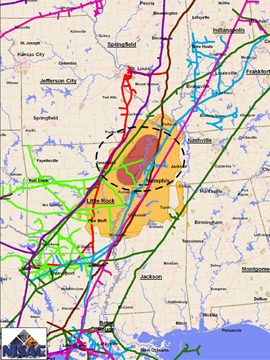
Designing robustness to save lives and reduce misery

Major earthquake events would not only cause a human catastrophe in the region directly damaged, but might also cause extensive harm far outside the earthquake zone by disrupting major infrastructure transmission lines. The New Madrid Seismic Zone (NMSZ) is both vulnerable to large earthquakes and is a major conduit for transmission lines from the Gulf of Mexico to the northeaster/n US. Designing appropriate robustness in this system has the potential to save lives and reduce misery.
Our goal for the project: Evaluate potential impacts of disruptions (due to earthquakes in NMSZ) on natural gas supplies (regionally to nationally); create a network flow model useful for analyzing natural gas and other systems constrained by transmission capacity; provide an allocation model that spreads disruption shortages among the end users.
We developed a simple network flow model to estimate disruption consequences and to place bounds on pipelines capacities using historical flow data. The model’s network topology is derived directly from industry pipeline location data. For analysis of the New Madrid Seismic Zone, the resulting model network was graphically overlaid on the pipeline network, and the locations and properties were reviewed and verified through GoogleEarth. Model testing was completed in 2009. Preliminary analysis of disruption consequences was conducted in 2009 and 2010.Other potential applications: estimation of patterns of service interruption arising from diverse causes, such as pipeline explosion or loss of storage, estimation of consequences of disruptions to international telecommunications cables.